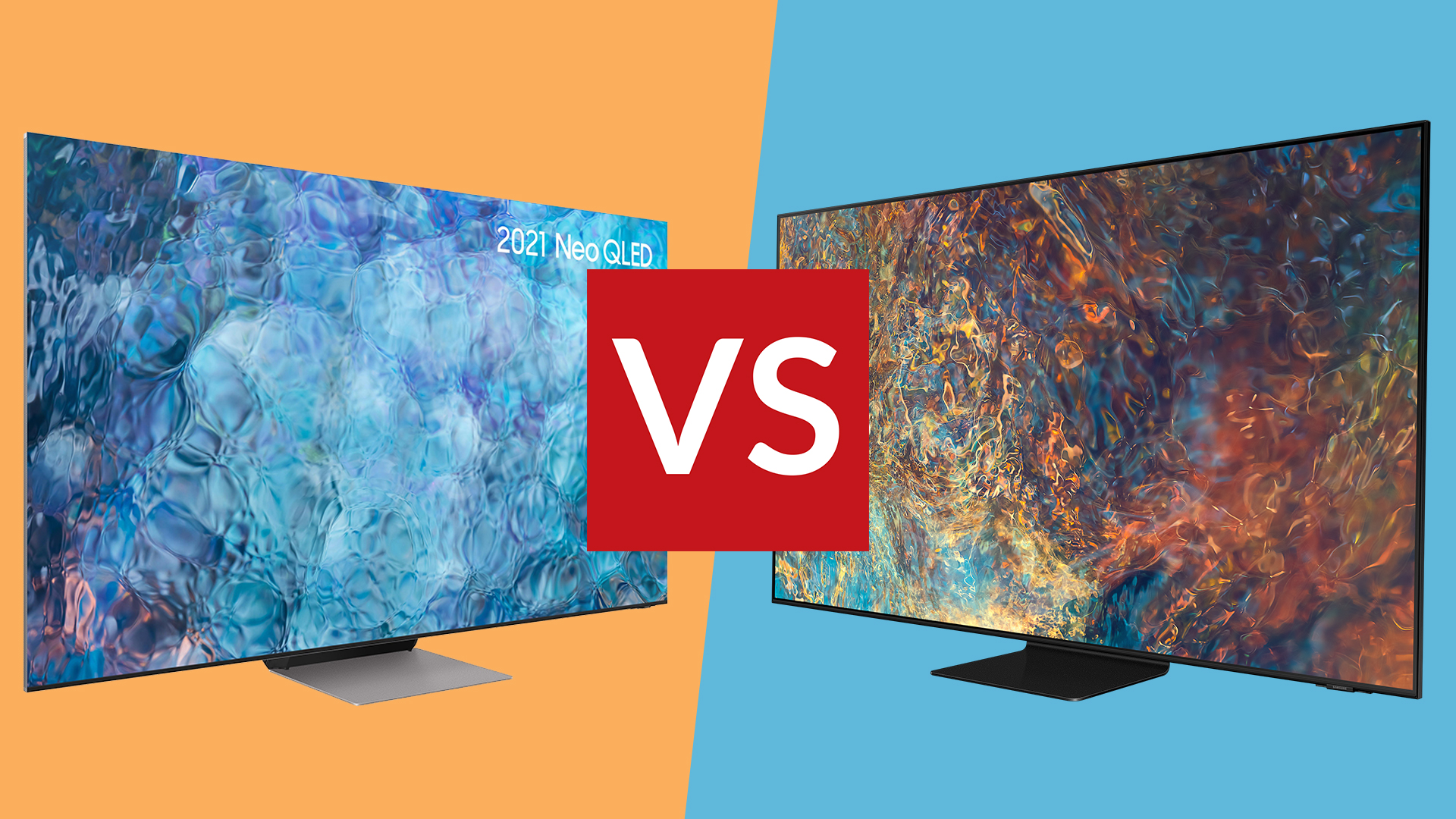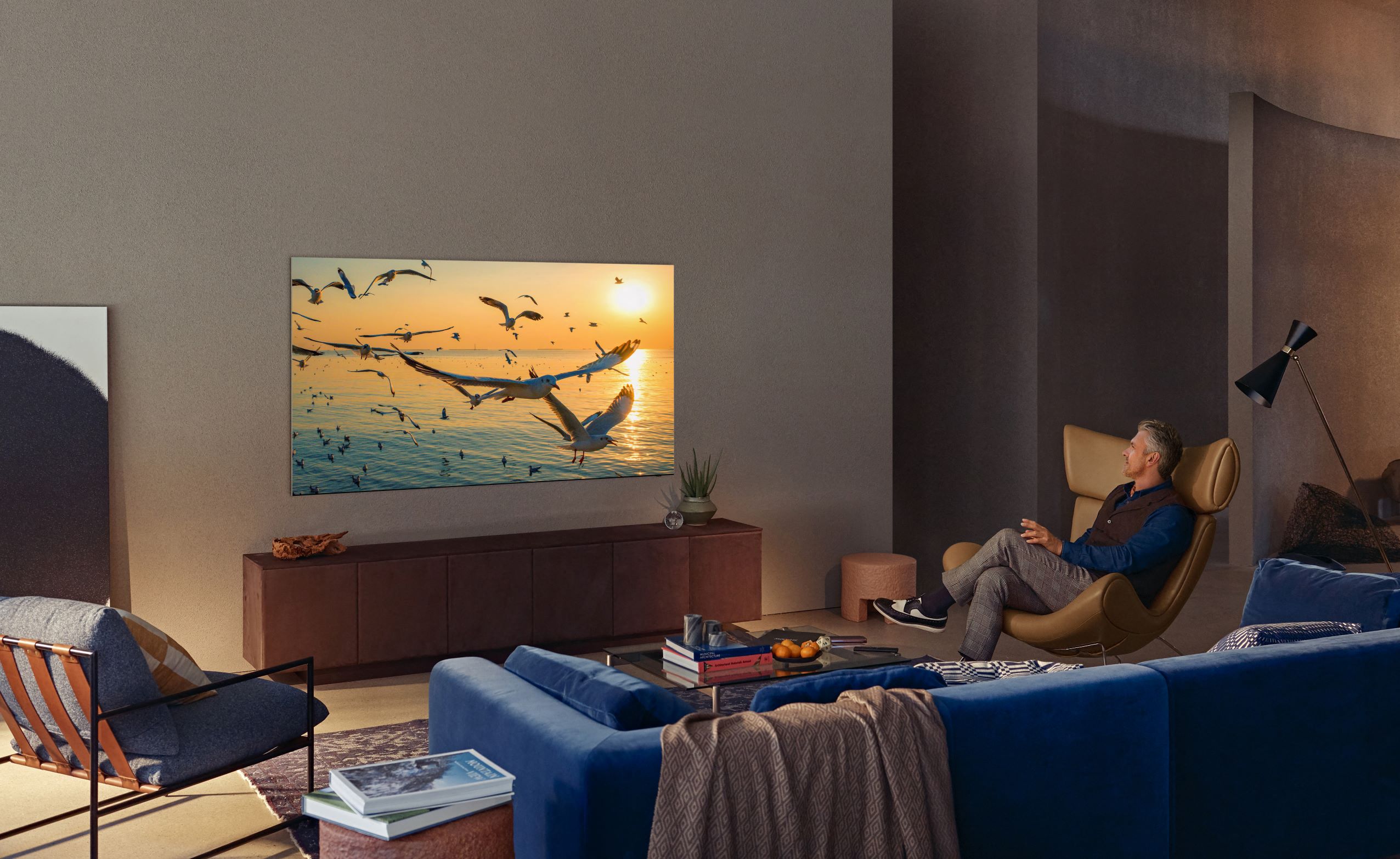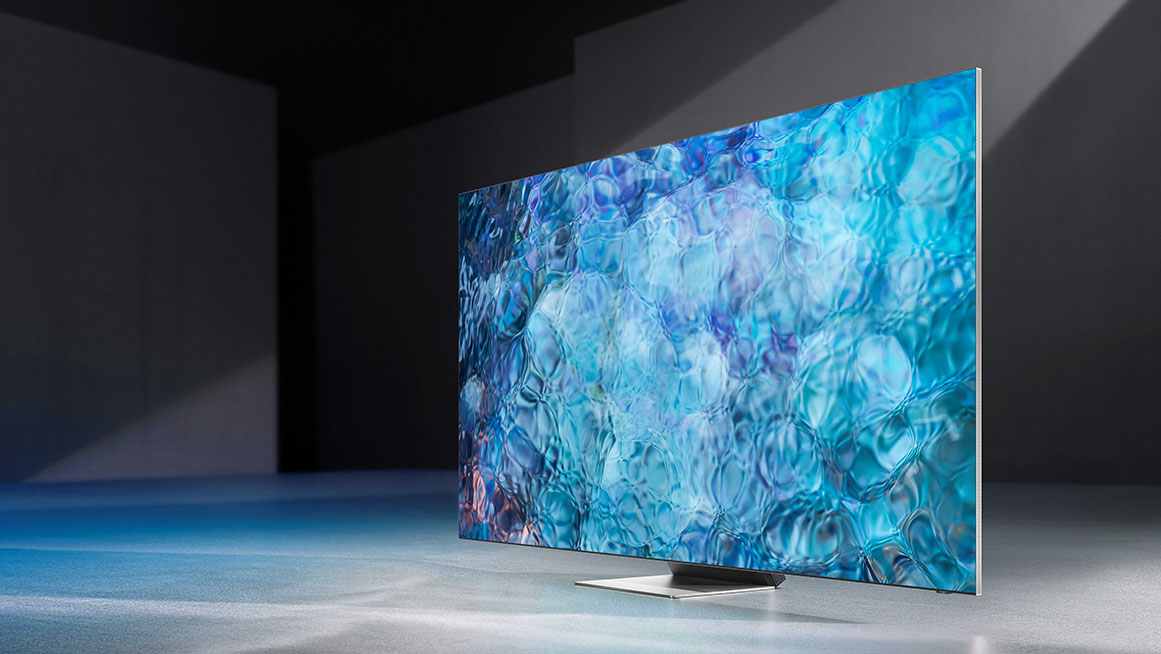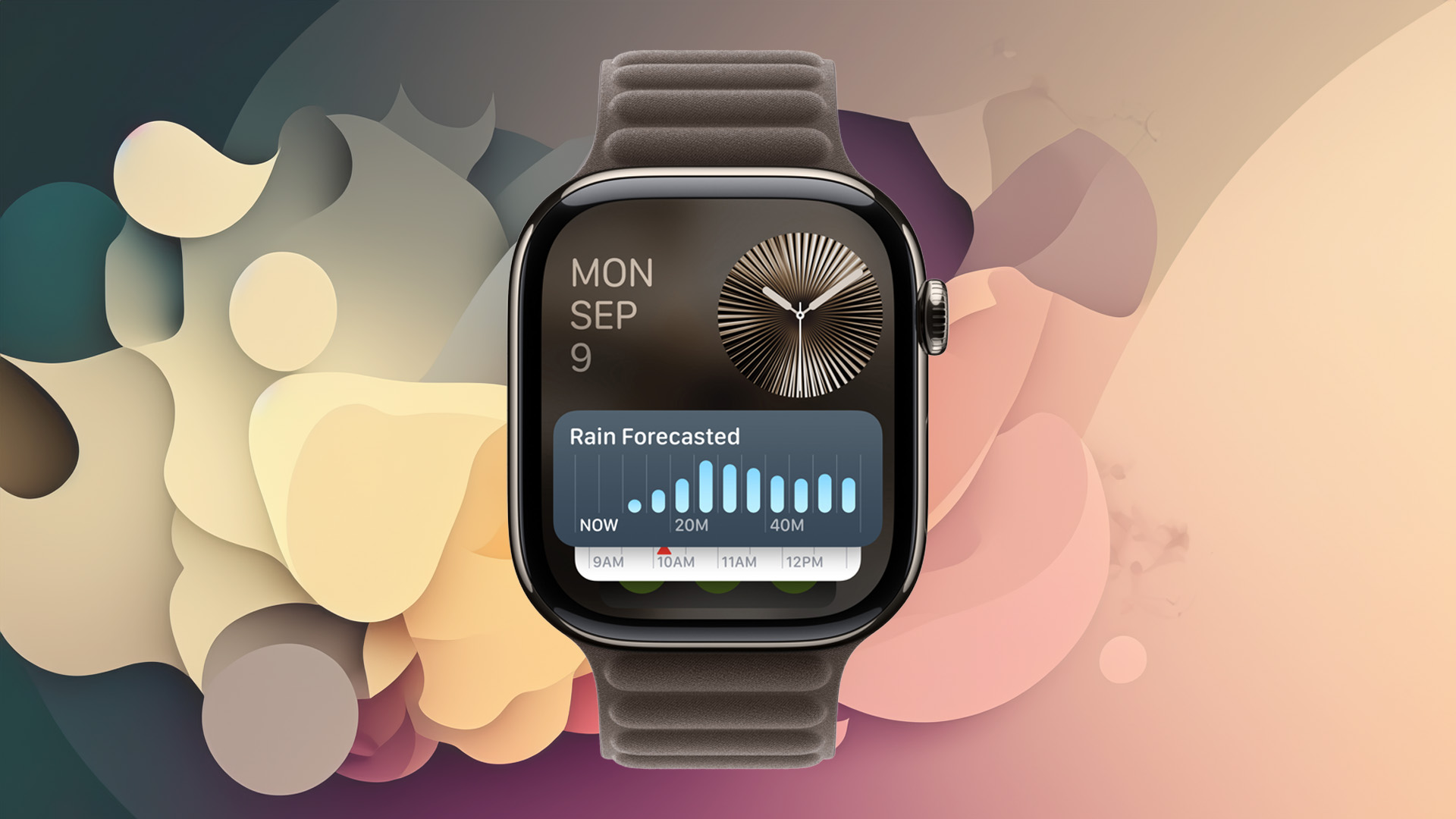

It’s time for a Mini-LED face off. Samsung’s 2021 flagships, the first Neo QLED TVs to launch, make the most of Mini-LED technology to bring in OLED-rivalling black levels and improved contrast and brightness. Both the Samsung QN90A and the Samsung QN900A are part of the Neo QLED range, indicated by the N in their name.
But there is one immediate difference between these two screens: The QN90A is 4K and the QN900A is an 8K TV. That means we're talking two different prices as well as two different resolutions, but So which should you be investing in and which will rate higher in our list of the best TVs?
Here we’ll be comparing the Samsung QN90A and the Samsung QN900A across a number of key areas. We’ll break down those all important price points, explore the feature set of each one, and outline the big differences. We’ll also explain the differences between the US and European models of the QN90A and the other models available with very similar specs.
It’s also worth noting from the outset that both have HDMI 2.1 functionality so will be ideal for new PS5 and Xbox Series X owners to make the most of 4K gaming at 120fps. Expect these to be high on our list of the best gaming TVs on release but do read below as to how to make sure you get as many HDMI 2.1 ports as possible.
These are designed to really make the most of being at big screen sizes, especially the 8K model – it's looking at the best 65-inch TVs and up that 8K gets a chance to really shine.
Samsung QN90A vs Samsung QN900A: Price and models

First off, that all-important price point. Across the board Samsung’s 2021 Neo QLED range is slightly more expensive than the previous year's equivalent QLED models. Mini-LED is not a cheaper technology so there’s slightly more of an investment to make if you’re hungry for improved brightness. However, you'll get a better bargain compared to looking at the QN90B or QN900B 2022 flagships by comparison, so we'd suggest sticking to the year older model for value sakes.
It’s key to note too that the QN90A is actually available in different sizes in the US and the UK and the two are slightly different televisions. The QN90A in the USA will be available in a 55-inch model for $1799, 65-inch for $2599.99, 75-inch for $3499.99 and a whopping 85-inch model for $4999.99. The US model has Samsung’s ultra-wide viewing angle tech and an anti-glare filter, meanwhile the UK variant of the QN90A doesn’t have this. In the UK the QN90A is available in a 50-inch model for £1,799, a 55-inch for £1,999, and a 65-inch version for £2,799.
Sign up to the T3 newsletter for smarter living straight to your inbox
Get all the latest news, reviews, deals and buying guides on gorgeous tech, home and active products from the T3 experts
On the other hand, the flagship 8K Samsung QN900A is the same screen in both countries. In the US the 65-inch model is $4,999, the 75-inch model is $6,999, and the 85-inch model is $8,999. UK prices are £5,999 for the 65-inch model, £7,999 for the 75-inch, and an eye-watering £11,999 for the 85-inch model.
Here’s where things get slightly confusing. Also on the market in the UK are both the QN94A and the QN95A. The QN94A has that ultra-wide angle and improved anti-glare missing from the UK QN90A. The QN95A also has these but, importantly, includes Samsung’s One Connect box which means you don’t have a mess of wires coming from the back of your TV and instead have one thin wire to Samsung’s proprietary box, where you can plug in all of your HDMIs out of sight. You can read our full Samsung QN95A review here.
And this isn’t just an aesthetic decision, especially if you have multiple new-gen consoles. The One Connect Box actually means that you’ll have four HDMI 2.1 ports instead of just the one on the TV itself, as is the case with the QN90A. This could be a deal breaker if you have both a PS5 and Xbox Series X and don’t want to get up to change the HDMI. The 8K QN900A already has the One Connect Box as standard.
Samsung QN90A vs Samsung QN900A: Design & features

Both the QN90A and QN900A push the boat out when it comes to design. Almost bezel-less displays – pretty much edgeless when it comes to the QN900A – and a minimalist stand means a floating high resolution display that’s all about picture quality and very little else.
The big difference aesthetically, especially if you’re wall mounting them, will be the QN900A’s One Connect Box as there will only be one thin wire instead of multiple snaking HDMI leads trailing from the back (though Samsung has always provided great cable management in its stands). The QN900A also comes with that ultra wide viewing angle and anti-glare display as standard, unlike the UK QN90A where you’d need to upgrade QN94A or QN95A to get these.
For new-gen console owners, the QN90A and the QN900A both have a specific low lag Game Mode and HDMI 2.1 functionality, but there’s a big difference between the two. The One Connect Box on the QN900A means you’ll get four HDMI 2.1 ports with support for 4K 120Hz gaming, Variable Refresh Rate, and Auto Low Latency Mode, but the standard QN90A means you’ll only get one HDMI 2.1 port (plus three HDMI 2.0 ports). Again, an upgrade to the QN95A is vital if you want four HDMI 2.1 ports instead.
Both TVs come with Samsung’s intuitive Tizen smart platform, which allows multi view so you can watch multiple streams at once, and includes a handy Universal Guide to make browsing for content easier when it comes to various streaming services. This also gives access to Samsung’s Health platform with specific home exercise and mindfulness content if you want to escape from the madness of everyday life. The new Samsung Game Bar is a genuinely great addition for serious gaming fans.
Samsung QN90A vs Samsung QN900A: Picture quality

Both the Samsung QN90A and the Samsung QN900A make the most of Mini-LED technology. This means that the LEDs are now 1/40th the size of previous LEDs, meaning that there can now be far more squeezed into seriously slim designs. The more LEDs there are, the brighter a screen can be and the more precise its local dimming, therefore significantly improving our experience when it comes to brightness and contrast.
Obviously detail is where the biggest difference will lie between the two screens. The QN90A shares the same Samsung Neo Quantum Processor as the QN900A, but with a 4K resolution of 3840x2160 compare to the 7680x4320 of the 8K model. With the right image source, then, the QN900A can look even more like real life.
Given the lack of 8K content in the world, Samsung has crucially included 8K AI upscaling to bring our current media up to scratch. Thankfully, Samsung has excellent form when it comes to 8K upscaling. As you can see in our Samsung Q950TS review – ie our “new best TV on the planet” back in March last year – upscaled 4K content is a dream with Samsung’s upscaling tech, making it genuinely look better than 4K, even if it's not as good as native 8K footage would be. Expect this to look even better with Mini-LED tech backing it up.
The QN900A also has what Samsung is calling Quantum HDR 4000, which means that it can theoretically hit 4,000 nits of brightness. This is a huge amount – the best OLED TVs struggle to hit 1,000 nits. The QN90A is rated HDR 2000, which means it could hit around 2,000 nits of brightness. So the QN900A has an edge in that case, though we should stress that you won't really see this benefit in most picture, especially if you have the adaptive brightness on (as most people will). But if you want the best of the best brightness for taking advantage of HDR, the QN900A has an edge. Both sets supports HDR10+ for more vibrant colours and contrast, but there's no Dolby Vision support here.
When it comes to local dimming – the technology used in LED TVs to ensure deeper contrast in the areas that need it – there is an increased number of zones across both the QN90A and the QN900A. These obviously depend on the screen size, and while the QN900A hasn’t had numbers confirmed, according to Vincent Teoh at HDTV Test the QN90A has 576 zones in its 55-inch model, 792 in its 65-inch, and potentially over 1,000 in its 75-inch model. We expect the QN900A to have more than this, also giving it an edge over the QN90A when it comes to precise contrast as well as brightness (though both are still class-leading overall).
Samsung QN90A vs Samsung QN900A: Sound quality

Both the QN90A and the QN900A make the most of Samsung’s impressive proprietary Object Tracking Sound system. The QN90A’s 'Object Tracking Sound+' uses eight speakers around the edges to try to ensure you really don’t need a soundbar for a 3D audio experience – they shift elements of the sound around to match the action on-screen. It’s worth noting, though, that you’ll need to purchase the 55-inch model for this, because the 50-inch has what Samsung calls 'OTS Lite' with fewer speakers.
And of course, the QN900A goes bigger and better. 'Object Tracking Sound PRO' has 10 built-in speakers that include ones positioned in the centre of the screen to make sure that you don’t miss a single directional explosion.
Samsung QN90A vs Samsung QN900A: Verdict
So who wins? Well, both really. Samsung’s Mini-LED tech and connectivity means that the QN90A and QN900A are supremely exciting TVs but it’s all about resolution. Both are top of the range for their class but whether you can ignore that irresistible 8K upgrade is very much down to you and your purse strings. The QN900A is simply the pinnacle of Samsung's LCD TV tech right now.
But if you don’t see the need for that 8K boost, and you're happy with HDR brightness that's merely dazzling and not utterly retina-blowing, then the QN90A is a brilliant TV on both sides of the pond, but PS5 and Xbox Series X owners should consider the QN95A if you’re looking for those 4x HDMI 2.1 ports for new-gen gaming.
Now it's 2022 it's also worth noting that there are QN95B and QN900B models available too, with updated processing and better anti-glare across the board. However, they're far pricier, so buying into the 2021 range means you'll get top notch results at a more affordable price point. That'd be our suggestion!
Louise Blain is a journalist and broadcaster specialising in technology, gaming, and entertainment. She has a weekly consumer tech slot on BBC Radio Scotland and is the presenter of BBC Radio 3's monthly Sound of Gaming show. She can also regularly be found on BBC Radio 4, BBC Five Live, and The Evolution of Horror podcast as well as writing for GamesRadar and NME. Louise loves finding ways that tech can make our lives better every day and no, she doesn't have enough smart lighting yet.

